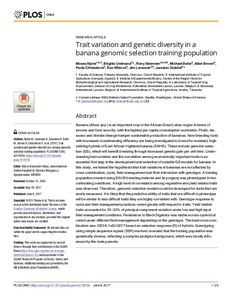| dc.contributor.author | Nyine, M. |
| dc.contributor.author | Uwimana, B. |
| dc.contributor.author | Swennen, R.L. |
| dc.contributor.author | Batte, M. |
| dc.contributor.author | Brown, A. |
| dc.contributor.author | Christelova, P. |
| dc.contributor.author | Hribova, E. |
| dc.contributor.author | Lorenzen, J.H. |
| dc.contributor.author | Dolezel, Jaroslav |
| dc.date.accessioned | 2019-12-04T11:08:54Z |
| dc.date.available | 2019-12-04T11:08:54Z |
| dc.date.issued | 2017-06-06 |
| dc.identifier.citation | Nyine, M., Uwimana, B., Swennen, R., Batte, M., Brown, A., Christelová, P. ... & Doležel, J. (2017). Trait variation and genetic diversity in a banana genomic selection training population. PLoS One, 12(6), e0178734. 1-23. |
| dc.identifier.issn | 1932-6203 |
| dc.identifier.uri | https://hdl.handle.net/20.500.12478/1935 |
| dc.description | Open Access Journal |
| dc.description.abstract | Banana (Musa spp.) is an important crop in the African Great Lakes region in terms of income and food security, with the highest per capita consumption worldwide. Pests, diseases and climate change hamper sustainable production of bananas. New breeding tools with increased crossbreeding efficiency are being investigated to breed for resistant, high yielding hybrids of East African Highland banana (EAHB). These include genomic selection (GS), which will benefit breeding through increased genetic gain per unit time. Understanding trait variation and the correlation among economically important traits is an essential first step in the development and selection of suitable GS models for banana. In this study, we tested the hypothesis that trait variations in bananas are not affected by cross combination, cycle, field management and their interaction with genotype. A training population created using EAHB breeding material and its progeny was phenotyped in two contrasting conditions. A high level of correlation among vegetative and yield related traits was observed. Therefore, genomic selection models could be developed for traits that are easily measured. It is likely that the predictive ability of traits that are difficult to phenotype will be similar to less difficult traits they are highly correlated with. Genotype response to cycle and field management practices varied greatly with respect to traits. Yield related traits accounted for 31–35% of principal component variation under low and high input field management conditions. Resistance to Black Sigatoka was stable across cycles but varied under different field management depending on the genotype. The best cross combination was 1201K-1xSH3217 based on selection response (R) of hybrids. Genotyping using simple sequence repeat (SSR) markers revealed that the training population was genetically diverse, reflecting a complex pedigree background, which was mostly influenced by the male parents. |
| dc.description.sponsorship | Bill & Melinda Gates Foundation |
| dc.format.extent | 1-23 |
| dc.language.iso | en |
| dc.subject | Genetic Variation |
| dc.subject | Genetic Variation |
| dc.subject | Genomic Selection |
| dc.subject | East African Highland Banana |
| dc.subject | Traits Variation |
| dc.title | Trait variation and genetic diversity in a banana genomic selection training population |
| dc.type | Journal Article |
| dc.description.version | Peer Review |
| cg.contributor.crp | Roots, Tubers and Bananas |
| cg.contributor.affiliation | Palacky University |
| cg.contributor.affiliation | International Institute of Tropical Agriculture |
| cg.contributor.affiliation | Institute of Experimental Botany, Czech Republic |
| cg.coverage.region | Africa |
| cg.coverage.region | East Africa |
| cg.coverage.country | Uganda |
| cg.isijournal | ISI Journal |
| cg.authorship.types | CGIAR and advanced research institute |
| cg.iitasubject | Banana |
| cg.iitasubject | Food Security |
| cg.iitasubject | Plant Genetic Resources |
| cg.journal | PloS ONE |
| cg.howpublished | Formally Published |
| cg.accessibilitystatus | Open Access |
| local.dspaceid | 85148 |
| cg.targetaudience | Scientists |
| cg.identifier.doi | https://doi.org/10.1371/journal.pone.0178734 |

